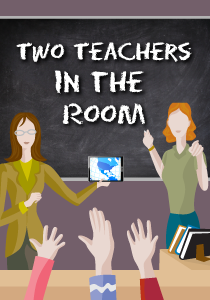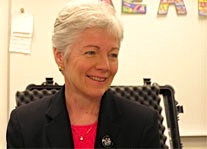Co-Teachers: Seamless but Not Interchangeable
A MiddleWeb Blog

So pull up a chair, and as you read, think about what you are thinking—this could get very interesting….
Wait — actually, before moving on, it’s a good time to share that I recently attended a BER conference presented by Dr. Marilyn Friend. That’s right, the awe-inspiring educator, consultant, professor, and co-teaching expert (I could go on and on!) who established the six models of co-teaching along with Dr. Lynne Cook.
Meeting Dr. Friend was definitely on my “things I hope to do during my career” list. Mission accomplished.
Dr. Friend shared so many thought-provoking ideas throughout the day that I decided to dedicate this post to just one of her ideas – the one that sparked my ah-ha moment. So here goes (now is a good time to get comfortable and sit back in that chair I told you to pull up).
Some background thoughts
We know that co-teaching is all about including all learners in a general education setting where they learn together. These learners are blended together within flexible grouping experiences to maximize learning for all. When we think about what the two teachers are doing, I am reminded of what I have always heard college professors, administrators, and colleagues say.
Specifically they’ve said that ideally when a visitor comes into a co-taught classroom, this visitor should not be able to distinguish the general education teacher from the special education teacher.
Have you ever heard this? This vision of the ideal co-taught classroom goes on to say that there should be a flow and a balance of teacher responsibilities, resulting in a fine tuned parity that blurs the line between the two educators. You just shouldn’t be able to tell who’s who!

But so far throughout my career, I’ve never really felt comfortable living out this expectation that visitors will be left to solve a “will the real special education teacher please stand up” puzzle. Up until now I could not explain why. And then came the moment during Dr. Friend’s presentation when it all became clear to me…
The Moment
In speaking about what effective co-teaching looks like, Dr. Friend offered a “what-if” question. I’ll summarize here.
What if, she asked, there were two general education teachers co-teaching? Well, you would get two teachers who focus on the material and the pacing—making sure that all of the content is taught. And what if you put two special education teachers together? Well, then you would get mastery of skills across the classroom.

“The joy of co-teaching is NOT for each teacher to be the same,” Dr. Friend said. “It is to celebrate, maximize, and understand what it means to guide every student to succeed.” And there you have it. My ah-ha moment.
I never really wanted a visitor to see me as an equivalent general education teacher. I never wanted to just blend in. I am a special education teacher—hear me roar!
Seeing the Difference
I think any visitor should come into a co-taught classroom and clearly see that each teacher brings a special skill set that ramps up the learning in unique ways. And as the co-teaching relationship develops, each can learn from the other and perhaps they can even exchange roles.
So, if the situation calls for it, you might see a general education teacher focusing on the scaffolding and data collection, while the special education teacher teaches the content. But special education teachers should always add something different—something should be added to the class that creates specialized instruction.

And dare I say, if nothing different is happening in the co-taught classroom then learning is not happening for many students in the room. It’s as simple as that.
The Road to True Parity
My deepened awareness brings me to five actions that the two teachers in the room can pursue to create true parity.
1. Value Expertise of One Another: Each co-teacher should recognize the expertise and potential in the other. Put aside egos and realize that each of you brings a specific ability that can amplify learning for all learners in the room (including the two of you!). For example, the special education teacher can share instructional methodologies, behavior or classroom management techniques, and data collection ideas that can lead to more success across the room.
2. Do your Homework: Each teacher should expand his expertise. For example, the special education teacher should learn the content well. We are best at exerting our learning expertise when knowledge of the content is embedded in the process. The general education teacher should become adept at using strategies and methodologies that facilitate learning and positive classroom culture.
3. Be Seamless but Not Interchangeable: Each teacher should be an active part of class time. The special education teacher should be bringing something different to the classroom as the content is being effectively shared. See my last blog post about specially designed instruction for more details.

5. Check-In Often: Co-teachers must stay connected. They must be willing to have critical co-teaching conversations and also check in with one another often to share, reflect, plan, and then put it all into action!
So here’s the hot button question—what do you think? Should the two teachers in the room be unidentifiable? Should you be able to tell who’s the general education teacher and who’s the special education teacher?




































I am a firm believer that, in the co-teach setting, the two teachers should share equal but different responsibilities. To a stranger entering the room, they may be perceived as two teachers. To administration within the district they could well be perceived as general ed and special ed BUT the administrator should not be able to distinguish the special education students from the general education students unless there is an obvious physical clue. In my last year of teaching, I actually had a Principal not realize who the classroom students were. That’s how it should be. He was evaluating me, so of course, he knew the difference in the teachers but we, at the time, were “teaching up a storm” so he could not really tell that my subject knowledge was lacking.
Sanna, I love it–“teaching up a storm”! Now there’s the making for a great blog post! I found myself nodding and cheering with enthusiasm as I read your post! Thank you for what I consider, spot on! insights–thanks for sharing!
I think gen ed teachers need to be more than content delivers; they need to consider the audience/learner.
Extraknowing, agreed! And that’s what makes the gen. ed. and spec. ed. pairing so potentially powerful! Both teachers share their expertise, learn from one another, and expand their teaching behaviors, knowledge, and willingness to apply. Thanks so much for adding your spark to the discussion!
I am a veteran special education teacher for 5/6th grade math AND literacy. I work with two exceptional mathematics teachers and two exceptional literacy teachers. I work in a “co-taught” classroom on a daily basis with two of these four teachers. ALL of these teachers teach their lessons three times per/day to three different classes. I find that they have the lesson down to a science when I arrive to their classroom. I work with the students that benefit from a small group setting and value from extra review and practice, manipulatives, and pre-teaching strategies.
Often times we will go to a small group setting at the beginning of the classroom to do our own “opener” that is a review and practice of skills to help the students to master the common core standards. We work in a small group setting to work on the key concepts through extra practice. We use the manipulatives to help the students to master the skills. I try to use four modalities of learning (i.e. visual, auditory, kinesthetic, tactile) and integrate these modalities as much as possible with the given lessons. In the small group setting, students have the ability to ask questions and I can monitor their individual success with given problems on a regular basis.
After the 20 minute opener, the students will return to the classroom for the “lesson” that is usually presented by the general education teacher while I circulate around the classroom to assist students with note taking, rereading of material and time on task. These strategies assist the students within the general education classroom pace of instruction and with the daily content expectations.
The key to success is a juggling act, really! The students deserve the rigor, content grade-level exposure to the common core standards, as well as accommodations to succeed. Trying to determine the amount of accommodations, interventions, review and practice with the students is where the juggling begins!
The general education teachers’ pace of instruction is often times a challenge or barrier for the struggling learners. As a special education teacher, I feel it is my role to communicate with the general education teacher to determine the key concepts to focus on with my students so that the students are prepared and master the important “essential skills” at their grade level placement.
So, if I had only ONE content area to prepare, I would agree that a visitor would not be able to tell the difference between us. But the reality of the responsibilities of a special educator is not just ONE subject/content area to teach. I currently work with a 5th grade literacy teacher, 5th grade mathematics teacher, 6th grade mathematics teacher, and a 6th grade literacy teacher. I teach a 5th grade supplemental phonics small group (Sharon Walpole strategies), 5th grade supplemental reading comprehension skills group (Cafe strategies), 6th grade supplemental phonics small group (Walpole) and a 5th grade math supplemental group (preteaching for content area instruction). I would classify it as the “perfect storm” in regards to time management, preparation and juggling of skill development. This does not even count IEP writing or progress monitoring with my special education students.
Sounds similar to my setting, working with multiple GREAT classroom teachers with little to no planning time. Data supports “it’s” working but I would not call it “true” co-teaching.
Tana, Wow! Thank you for summarizing a day in the life! Bottom line is you take an active part in advocating for what students need–and–you take action in applying a variety of teaching structures and strategies to guide your students to meet with personal success.
Thanks, Nely Navas de Rentas, for adding your connection! I think it has all the makings of “true” co-teaching. For example, Tana, if you incorporate consistent small group teaching within the classroom, you and your co-teacher will be able to integrate a station teaching model. Also, you can focus on the pacing as you work toward guiding students to master the essential skills and concepts through a parallel teaching structure. Check out the variety of co-teaching models (click the six models link above) and get into a consistent groove, so you may walk into your classroom ready to go with the flow! And the best part is you and your co-teacher will be able to plan independently, yet come together as one! Easier said than done, I know. But it sounds like you and your co-teacher have all the makings for success!
Absolutely! You should be able to tell the difference, otherwise, what is the difference? This article has the best pointers I’ve read on co-teaching. Unfortunately we are not given the professional time to work as this article and many other research based models recommend. Administrators seem to think that: 1) co/teachers can plan through email, 2) special ed teachers can have many co-teachers not one, 3) instructional planning time is not needed, and 4) sorry work it out before or after school. How about an article stating clearly, without uninterrupted weekly instructional planning time, it’s not co-teaching. It’s you do your thing I’ll do mine, shake. See everyone, we are co-teaching.
Right, Nely Navas de Rentas! “otherwise, what is the difference?”! There should be a difference in the co-taught classroom. BUT the difference should be a process difference–not a content or level of high expectations difference!
Love your idea for an article: “How about an article stating clearly, without uninterrupted weekly instructional planning time, it’s not co-teaching? It’s you do your thing I’ll do mine, shake. See everyone, we are co-teaching.” But the reality is what it is–so it becomes what CAN we do about it. And there are realistic actions the two teachers can take in situations where co-planning time just doesn’t exist. Find me on Twitter if you’d like to begin to collaborate on the article you suggested. (@elizabethlstein) Otherwise stay tuned, I will have a post on what you suggest. I will begin to think on this because you’ve really sparked me with your post! Many thanks!